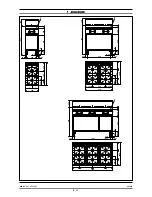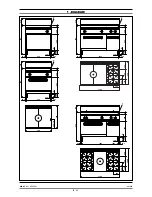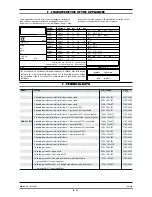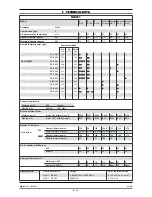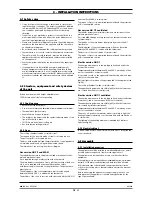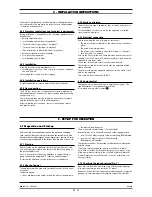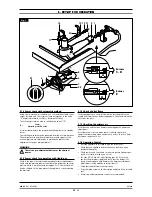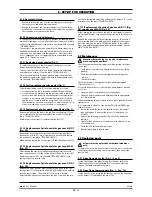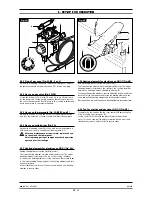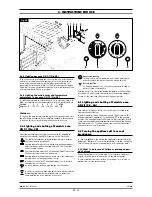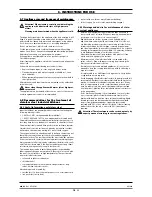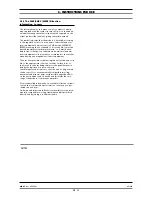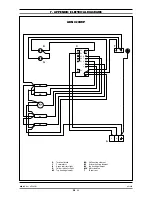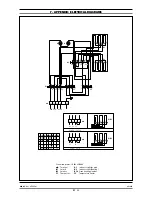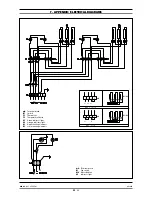
6 - INSTRUCTIONS FOR USE
6.7 Appliance care and frequency of maintenance
Attention! When cleaning, carefully avoid washing the
appliance with direct water jets or high-pressure
water!
Cleaning must be performed when the appliance is cold.
Thorough daily cleaning of the appliance, after disconnecting it, will
keep it in perfect working order and make it last longer. All steel
parts should be cleaned with water and a detergent, using a damp
cloth; do not use abrasive substances or corroding detergents.
Do not use steel wool, which could cause rust to form.
For the same reason, avoid touching the appliance with anything
made of iron. Do not clean with sandpaper and lubricating gel paper.
If absolutely necessary, you may use pumice powder.
If the appliance is extremely dirty, use a synthetic sponge (i.e.
Scotchbrite sponge).
After cleaning the appliance, rinse with clean water and wipe with a
clean cloth.
If the main burner needs cleaning, proceed as follows:
• Remove the pan support, cover, rings and burner crown;
• Clean burner parts with water, soap and a suitable tool, then
rinse and wipe;
• When reassembling the parts, make sure you place them back in
the right position.
All maintenance and repair work must be carried out by authorized
technicians only.
Never clean the appliance with water jets or high-pres-
sure water!
The appliance must be checked at least once a year. For this reason,
a service agreement contract is recommended.
6.8 Recommendations for the treatment of
stainless steel industrial kitchens
6.8.1 Useful information on stainless steel
Industrial kitchens are generally made of stainless steel having the
following material codes:
• 1.4016 or 1.4511 = magnetizable chromed steels
• 1.4301, 1.4401 and 1.4571 = non-magnetizable chromed steels
Chromed steels have favourable thermo-technical characteristics. In
fact, they have less of a tendency to warp due to the effect of heat.
Chrome-nickel steels, instead, have good corrosion resistance features.
Stainless steel corrosion resistance is given by an inactive coat that
builds up on the surface by coming into contact with oxygen.
The oxygen in the air is already enough to build up the inactive coat
that allows automatic removal of anomalies and damage due to
mechanical actions. The inactive coat builds up or re-builds up faster
if the steel comes in contact with running water containing oxygen.
A more powerful effect is given by oxidative acids (nitric acid, oxalic
acid). These acids are used if the steel has undergone strong chemi-
cal stresses, hence generally losing its inactive coat.
The inactive layer can be chemically damaged or jeopardized by
reducing agents (oxygen consumption) if they come in contact with
the steel, concentrated or at high temperatures. These active sub-
stances include for instance:
• saline and sulphurous substances
• chlorides
(salts)
• concentrated spices such as mustard, vinegar essences, soup
cubes, kitchen salt solutions, etc.
More damage can be caused by:
• outside rust (i.e. from other components, tools or incipient rust)
• iron particles (i.e. file dust)
• contact with non-ferrous metals (element build up)
• lack of oxygen (i.e. no air inlet, water lacking oxygen).
6.8.2 Warnings and advice for maintenance of stain-
less steel appliances
• Stainless steel equipment surfaces must be kept clean and in
contact with air at all times. When not running, keep appliance
doors open so as to allow air to run through it.
• Regularly remove calcium , grease, starch, and egg white
deposits where rust may build up if there is lack of air. Do not
use bleaching products or products containing chloride. Follow
all indications given by the company concerning special soaps
and cleaning methods to be used for the appliance. If no specific
cleaning recommendations are available, it is necessary, however,
to use detergents having a low chloride content.
After cleaning, remove all soap residues with plenty of clean
water and thoroughly dry the surfaces.
• Minimize contact of stainless steel with concentrated acids,
spices, salts, etc. Even acid vapours coming from cleaning the
tiles favour stainless steel corrosion.
• IParticularly for pots and multiple appliances, it is not recom-
mended to load the cooking chamber only with food having a
high salt content.
It is preferable to cook different food together, i.e. fatty dishes
or vegetables containing acids.
• Avoid damaging the stainless steel surface, in particular with dif-
ferent metals. Residues from other metals help build up the for-
mation of chemical microelements that may cause rust. At any
rate, it is appropriate to avoid contact between iron and steel
since it produces rust. Any contact between stainless steel and
iron (steel wool, pipeline chips, chalybeate waters) can start cor-
rosion phenomena.
As for mechanical cleaning, it is recommended to use only steel
wool or natural, plastic or steel bristle brushes. Steel wool or
brushes with stainless steel can cause rust due to rubbing. Newly
formed rust spots can be removed with slightly abrasive liquid
soaps or fine-grained sand paper. Larger rust spots can be
removed with 2-3% of hot oxalic acid solution. If these cleaning
products do not do the job, a nitric acid (10%) treatment is
required.
Attention! These treatments can be carried out only by
expert personnel according to current regulations.
020_03
- GAS KITCHENS
18
· 23
03/2006

